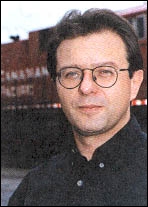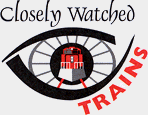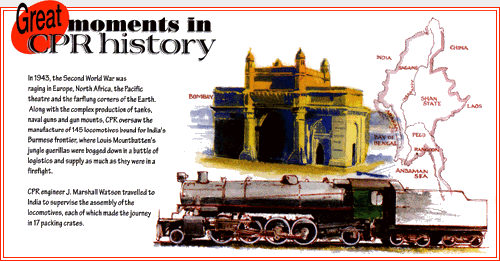
|
VOLUME THIRTY-ONE
|
NUMBER FOUR 2001
|
Is P3 the Future of Railroading?
| |

By Greg Gormick.
|
The CPR made headlines in Canadian newspapers in September
in connection with a topic that, increasingly, you're going to hear more about. In government circles, it's
referred to as P3. For railroaders, it could mean the unleashing of the potential many have been advocating
for years.
P3 stands for private/public partnerships. Or, if you're in government, public/private partnerships. In its
simplest terms, it means that both private companies and the public sector share the cost of projects that
have benefits for both those private companies and the public.
For railroading specifically, it would mean public money added to that put up by the railways to build or
expand lines, facilities, or services. That would make it easier for railways to divert traffic from
publicly-funded highways by providing the capacity and service that would be attractive to
shippers, intercity passengers, and/or commuters.
 The public benefits by not having to fund new or expanded highways.
The public benefits by not having to fund new or expanded highways.
Both partners must get a good return on their investment - economic and/or social - or the model doesn't
work.
Mug's Game
Federal transport minister David Collenette recently told Toronto radio listeners that expanding the highway
system is "a bit of a mug's game; you get a Los Angeles phenomenon. The more you build roads, the more
people will fill them."
The CPR proposal that gained headlines is for the expansion and improvement of the
Montreal-Toronto-Windsor corridor, which is paralleled by Highway 401, one of the busiest roads
in the world. The jointly-funded project would divert as many as one million trucks off this
overloaded highway. It would also save taxpayers billions more in highway expansion and maintenance.
Response to the proposal has been mixed. The Ontario Trucking Association and the Ontario minister of
transport disagreed with it. Collenette saw its possibilities, having already asked Canada's railways to come
up with suggestions for getting freight off the roads and onto trains. The Toronto Star - Canada's
best-selling newspaper - heartily endorsed the idea.
Under Way in the U.S.
Those who recoil in horror at the idea of public money going into privately-funded railways may
not be aware that the P3 concept is one that is gaining acceptance worldwide. In the U.S., a number of P3
projects are either under way or under serious discussion.
One that's nearing completion is the Alameda Corridor. This $2.4-billion U.S. project is
amalgamating a disjointed network of freight lines that served the Port of Los Angeles into a fast, high
capacity, 20-mile line. It will speed the arrival and departure of Union Pacific and Burlington
Northern Santa Fe container trains that link the port to all of North America. It eliminates multiple
rights-of-way and grade crossings and makes the trains and the port much more efficient and
fluid.
Reasons are Clear
The Port of Los Angeles is the world's largest port container facility. the port - not Hollywood movie making
- is the main driver of the southern California economy.
Federal, state, and local politicians saw the wisdom of investing public money, in partnership with private
railway funds, to secure the future of the Port of Los Angeles and the railways that are its lifeline.
And other U.S. legislators are coming to the same conclusion. The State of Virginia, in particular, is
interested in a Norfolk Southern proposal for an NS/state/federal funding partnership to
double-track its line between Harrisburg, Pa., and Knoxville, Tenn. Under this scenario, a
government investment of $1.2-billion U.S. would eliminate the need for a
$3.3-billion widening of the parallel Interstate 81. Truck traffic would be diverted to rail by
the improvement and expansion of this existing rail corridor, resulting in numerous safety and environmental
gains as well.
Similarly, the Ohio-Kentucky-Indiana Regional Council of Governments has formed the
North-South Initiative to study the potential for eliminating congestion on Interstate 75 - the
nation's busiest truck route - by investing in and boosting capacity on parallel NS and CSX main lines.
We're still on the learning curve in Canada when it comes to railways and the P3 concept. Some vested
interests will never agree with it. But there is increasing evidence the public wants to see more freight and
passengers off the roads and on the rails. That will take money - lots of it.
Key to Service
When he appeared before the U.S. Senate Commerce Committee's subcommittee on surface transportation, UP chief
executive officer Dick Davidson spelled it out simply and eloquently: "The real key to service is
investment. Capital investment in the rail industry is like food to the human body. Without it, we will wither
and die".
Greg Gormick is a Toronto transportation analyst and
writer. The Views expressed are his own and do not necessarily reflect those of the Canadian Pacific
Railway.

This Canadian Pacific
Railway News article is copyright 2001 by the Canadian Pacific Railway and is reprinted here
with their permission. All photographs, logos, and trademarks are the property of the Canadian Pacific Railway
Company.
|
|